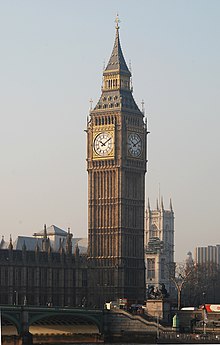
Back Куранты Byelorussian Rellotge de carilló Catalan Schlagwerk (Uhr) German Sonorhorloĝo Esperanto Reloj de sonería Spanish Jam berdenting Malay Slaguurwerk Dutch Куранты Russian Slagverk (ur) Swedish Куранти Ukrainian

A striking clock is a clock that sounds the hours audibly on a bell, gong, or other audible device. In 12-hour striking, used most commonly in striking clocks today, the clock strikes once at 1:00 am, twice at 2:00 am, continuing in this way up to twelve times at 12:00 mid-day, then starts again, striking once at 1:00 pm, twice at 2:00 pm, up to twelve times at 12:00 midnight.
The striking feature of clocks was originally more important than their clock faces; the earliest clocks struck the hours, but had no dials to enable the time to be read.[1] The development of mechanical clocks in 12th century Europe was motivated by the need to ring bells upon the canonical hours to call the community to prayer. The earliest known mechanical clocks were large striking clocks installed in towers in monasteries or public squares, so that their bells could be heard far away. Though an early striking clock in Syria was a 12-hour clock, many early clocks struck up to 24 strokes, particularly in Italy, where the 24-hour clock, keeping Italian hours, was widely used in the 14th and 15th centuries. As the modern 12-hour clock became more widespread, particularly in Great Britain and Northern Europe, 12-hour striking became more widespread and eventually became the standard. In addition to striking on the hour, many striking clocks play sequences of chimes on the quarter-hours. The most common sequence is Westminster Quarters.
Today the time-disseminating function of clock striking is almost no longer needed, and striking clocks are kept for historical, traditional, and aesthetic reasons. Historic clock towers in towns, universities, and religious institutions worldwide still strike the hours, famous examples being Big Ben in London, the Peace Tower in Ottawa, and the Kremlin Clock in Moscow. Home striking clocks, such as mantel clocks, cuckoo clocks, grandfather clocks and bracket clocks are also very common.
A typical striking clock will have two gear trains, because a striking clock must add a striking train that operates the mechanism that rings the bell in addition to the timekeeping train that measures the passage of time.
- ^ Milham 1945, p. 197.
© MMXXIII Rich X Search. We shall prevail. All rights reserved. Rich X Search